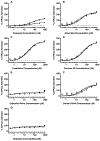Food dyes as P-glycoprotein modulators
- PMID: 33011351
- PMCID: PMC7736516
- DOI: 10.1016/j.fct.2020.111785
Food dyes as P-glycoprotein modulators
Abstract
The drug transporter P-glycoprotein (P-gp) is often investigated in drug-interaction studies because the activity is modulated by a wide variety of xenobiotics including drugs, herbal products, and food components. In this study, we tested six common arylsulfonate food dyes-allura red, carmoisine, ponceau 4R, quinolone yellow, sunset yellow, and tartrazine-as activators and inhibitors of P-gp activity in vitro. The dyes were studied as P-gp activators by measuring ATPase activity in P-gp-expressing membranes. Compared to verapamil, a known activator of P-gp, the six food dyes showed no stimulatory activity. The potential for these six food dyes to act as P-gp inhibitors was tested in an intracellular efflux assay with P-gp-expressing cells. Compared to GF120918, a known P-gp inhibitor, there was no inhibitory activity for these six food dyes. The six food dyes tested do not interact with P-gp in vitro and, therefore, are unlikely cause clinical drug-food dye interactions. Further investigation is necessary to determine whether these food dyes could interact with other drug transporters.
Keywords: Drug transporter; Food dye; P-glycoprotein.
Copyright © 2020 Elsevier Ltd. All rights reserved.
Conflict of interest statement
Declaration of Interest Statement
The authors report no conflict of interest.
Declaration of interests
The authors declare that they have no known competing financial interests or personal relationships that could have appeared to influence the work reported in this paper.
Figures



References
-
- Chequer FMD, Venancio V de P, de Souza Prado MR, Campos da Silva e Cunha Junior LR, Lizier TM, Zanoni MVB, Rodríguez Burbano R, Bianchi MLP, & Antunes LMG. (2015). The cosmetic dye quinoline yellow causes DNA damage in vitro. Mutation Research - Genetic Toxicology and Environmental Mutagenesis, 777(1), 54–61. 10.1016/j.mrgentox.2014.11.003 - DOI - PubMed
MeSH terms
Substances
Grants and funding
LinkOut - more resources
Full Text Sources
Miscellaneous

